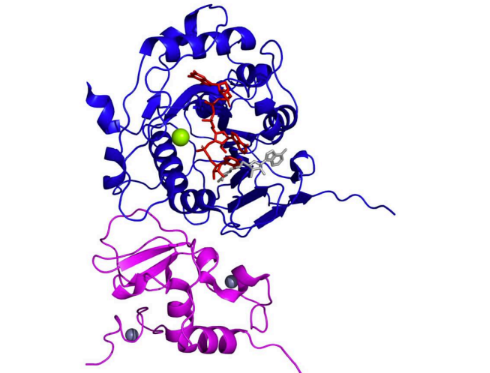Viruses are a unique entity that function by using certain tools present in normal host
cells that they themselves do not contain. Viruses generally consist of a lipid, or fatty, outer
layer, and an interior that contains DNA or its counterpart RNA. However, there is a whole
plethora of information to be discovered about the role of metals with regards to how viruses
use them. It has been shown before that different metals actually have different effects on metal
binding.
While zinc is most commonly associated with viruses, other metals such as iron, copper,
cobalt, and magnesium also help stabilize and regulate certain proteins and structures in
viruses and in our body. Supplementation with iron, for example, has been shown to increase
mortality rates in patients with HIV, which is thought to be due to iron’s role in regulating
transcription in our cells (Hakan Çam & Nimet Yılmaz, 2020). Copper has been long known as
an antimicrobial agent, and seems to affect the replication of viruses in the cell by producing
unstable reactive oxygen species that interfere with proteins necessary for replication.
You’ve probably heard of vaccines and other antiviral measures, especially after the
wake of the COVID pandemic in 2020. Vaccines contain either inactivated or small pieces of
virus that serve as a head start for the immune system to capture their antibodies so they can
be re-recognized upon actual infection. On the other hand, antiviral drugs typically work by
targeting specific proteins or compounds that are associated with the virus.

“Metal ions help COVID-19 virus to disguise itself” (Gupta, 2021)
In fact, one study from 2020 showed that a specific type of structured drug known as an
8-hydroxychloroquine was very effective at targeting certain enzymes that require metal-binding.
These drugs appeared to function by inhibiting DNA synthesis, which is a key aspect of viral
proliferation (DiScipio et al., 2022). In a different study done in 2010, the addition of zinc to a group of cells infected with coronavirus resulted in less virus reproduction. Upon further investigation, it was found that this was occurring because the zinc interacted with RNA binding proteins and prevented them from transcribing the RNA to make it into useful proteins for the virus (te Velthuis et al., 2010).
Clearly, viral replication is a crucial aspect of successful viral infection, and finding new ways to
inhibit these functions opens up more doors for more possible antidotes, especially for
permanent viruses such as herpes and HIV.
Sources:
Chaturvedi, U. C., & Shrivastava, R. (2005). Interaction of viral proteins with metal ions: role in
maintaining the structure and functions of viruses. FEMS Immunology & Medical
Microbiology, 43(2), 105–114. https://doi.org/10.1016/j.femsim.2004.11.004
de Jesus, J. R., & de Araújo Andrade, T. (2020). Understanding the relationship between viral
infections and trace elements from a metallomics perspective: implications for
COVID-19. Metallomics, 12(12), 1912–1930. https://doi.org/10.1039/d0mt00220h
DiScipio, K. A., Weerasooriya, S., Szczepaniak, R., Hazeen, A., Wright, L. R., Wright, D. L., &
Weller, S. K. (2022). Two-Metal Ion-Dependent Enzymes as Potential Antiviral Targets in
Human Herpesviruses. MBio. https://doi.org/10.1128/mbio.03226-21
Hakan Çam, & Nimet Yılmaz. (2020). Serum hepcidin levels are related to serum markers for
iron metabolism and fibrosis stage in patients with chronic hepatitis B: A cross-sectional
study. Arab Journal of Gastroenterology /Arab Journal of Gastroenterology, 21(2),
85–90. https://doi.org/10.1016/j.ajg.2020.04.013
te Velthuis, A. J. W., van den Worm, S. H. E., Sims, A. C., Baric, R. S., Snijder, E. J., & van
Hemert, M. J. (2010). Zn2+ Inhibits Coronavirus and Arterivirus RNA Polymerase Activity
In Vitro and Zinc Ionophores Block the Replication of These Viruses in Cell Culture.
PLoS Pathogens, 6(11), e1001176. https://doi.org/10.1371/journal.ppat.1001176


